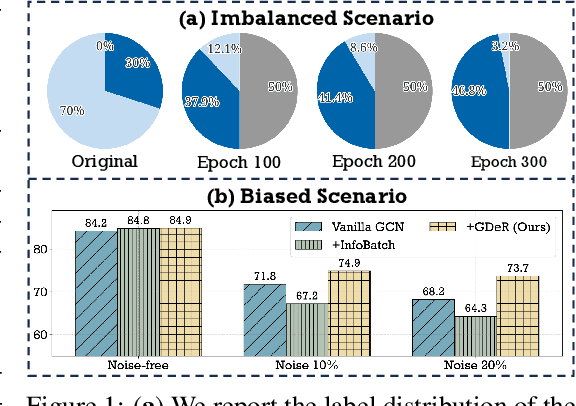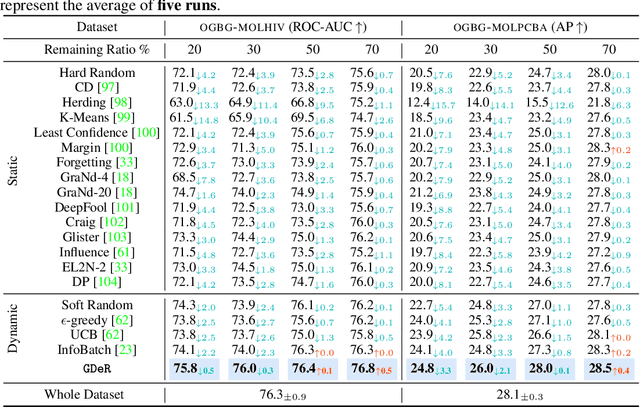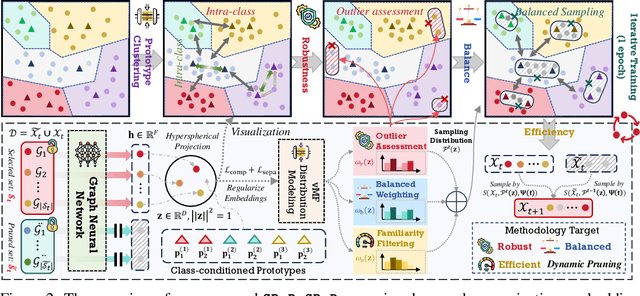Guibin Zhang
G-Memory: Tracing Hierarchical Memory for Multi-Agent Systems
Jun 09, 2025Abstract:Large language model (LLM)-powered multi-agent systems (MAS) have demonstrated cognitive and execution capabilities that far exceed those of single LLM agents, yet their capacity for self-evolution remains hampered by underdeveloped memory architectures. Upon close inspection, we are alarmed to discover that prevailing MAS memory mechanisms (1) are overly simplistic, completely disregarding the nuanced inter-agent collaboration trajectories, and (2) lack cross-trial and agent-specific customization, in stark contrast to the expressive memory developed for single agents. To bridge this gap, we introduce G-Memory, a hierarchical, agentic memory system for MAS inspired by organizational memory theory, which manages the lengthy MAS interaction via a three-tier graph hierarchy: insight, query, and interaction graphs. Upon receiving a new user query, G-Memory performs bi-directional memory traversal to retrieve both $\textit{high-level, generalizable insights}$ that enable the system to leverage cross-trial knowledge, and $\textit{fine-grained, condensed interaction trajectories}$ that compactly encode prior collaboration experiences. Upon task execution, the entire hierarchy evolves by assimilating new collaborative trajectories, nurturing the progressive evolution of agent teams. Extensive experiments across five benchmarks, three LLM backbones, and three popular MAS frameworks demonstrate that G-Memory improves success rates in embodied action and accuracy in knowledge QA by up to $20.89\%$ and $10.12\%$, respectively, without any modifications to the original frameworks. Our codes are available at https://github.com/bingreeky/GMemory.
UniErase: Unlearning Token as a Universal Erasure Primitive for Language Models
May 21, 2025Abstract:Large language models require iterative updates to address challenges such as knowledge conflicts and outdated information (e.g., incorrect, private, or illegal contents). Machine unlearning provides a systematic methodology for targeted knowledge removal from trained models, enabling elimination of sensitive information influences. However, mainstream fine-tuning-based unlearning methods often fail to balance unlearning efficacy and model ability, frequently resulting in catastrophic model collapse under extensive knowledge removal. Meanwhile, in-context unlearning, which relies solely on contextual prompting without modifying the model's intrinsic mechanisms, suffers from limited generalizability and struggles to achieve true unlearning. In this work, we introduce UniErase, a novel unlearning paradigm that employs learnable parametric suffix (unlearning token) to steer language models toward targeted forgetting behaviors. UniErase operates through two key phases: (I) an optimization stage that binds desired unlearning outputs to the model's autoregressive probability distribution via token optimization, followed by (II) a lightweight model editing phase that activates the learned token to probabilistically induce specified forgetting objective. Serving as a new research direction for token learning to induce unlearning target, UniErase achieves state-of-the-art (SOTA) performance across batch, sequential, and precise unlearning under fictitious and real-world knowledge settings. Remarkably, in terms of TOFU benchmark, UniErase, modifying only around 3.66% of the LLM parameters, outperforms previous forgetting SOTA baseline by around 4.01 times for model ability with even better unlearning efficacy. Similarly, UniErase, maintaining more ability, also surpasses previous retaining SOTA by 35.96% for unlearning efficacy, showing dual top-tier performances in current unlearing domain.
A Comprehensive Survey in LLM(-Agent) Full Stack Safety: Data, Training and Deployment
Apr 22, 2025Abstract:The remarkable success of Large Language Models (LLMs) has illuminated a promising pathway toward achieving Artificial General Intelligence for both academic and industrial communities, owing to their unprecedented performance across various applications. As LLMs continue to gain prominence in both research and commercial domains, their security and safety implications have become a growing concern, not only for researchers and corporations but also for every nation. Currently, existing surveys on LLM safety primarily focus on specific stages of the LLM lifecycle, e.g., deployment phase or fine-tuning phase, lacking a comprehensive understanding of the entire "lifechain" of LLMs. To address this gap, this paper introduces, for the first time, the concept of "full-stack" safety to systematically consider safety issues throughout the entire process of LLM training, deployment, and eventual commercialization. Compared to the off-the-shelf LLM safety surveys, our work demonstrates several distinctive advantages: (I) Comprehensive Perspective. We define the complete LLM lifecycle as encompassing data preparation, pre-training, post-training, deployment and final commercialization. To our knowledge, this represents the first safety survey to encompass the entire lifecycle of LLMs. (II) Extensive Literature Support. Our research is grounded in an exhaustive review of over 800+ papers, ensuring comprehensive coverage and systematic organization of security issues within a more holistic understanding. (III) Unique Insights. Through systematic literature analysis, we have developed reliable roadmaps and perspectives for each chapter. Our work identifies promising research directions, including safety in data generation, alignment techniques, model editing, and LLM-based agent systems. These insights provide valuable guidance for researchers pursuing future work in this field.
Aligning Multimodal LLM with Human Preference: A Survey
Mar 18, 2025Abstract:Large language models (LLMs) can handle a wide variety of general tasks with simple prompts, without the need for task-specific training. Multimodal Large Language Models (MLLMs), built upon LLMs, have demonstrated impressive potential in tackling complex tasks involving visual, auditory, and textual data. However, critical issues related to truthfulness, safety, o1-like reasoning, and alignment with human preference remain insufficiently addressed. This gap has spurred the emergence of various alignment algorithms, each targeting different application scenarios and optimization goals. Recent studies have shown that alignment algorithms are a powerful approach to resolving the aforementioned challenges. In this paper, we aim to provide a comprehensive and systematic review of alignment algorithms for MLLMs. Specifically, we explore four key aspects: (1) the application scenarios covered by alignment algorithms, including general image understanding, multi-image, video, and audio, and extended multimodal applications; (2) the core factors in constructing alignment datasets, including data sources, model responses, and preference annotations; (3) the benchmarks used to evaluate alignment algorithms; and (4) a discussion of potential future directions for the development of alignment algorithms. This work seeks to help researchers organize current advancements in the field and inspire better alignment methods. The project page of this paper is available at https://github.com/BradyFU/Awesome-Multimodal-Large-Language-Models/tree/Alignment.
Privacy-Enhancing Paradigms within Federated Multi-Agent Systems
Mar 11, 2025Abstract:LLM-based Multi-Agent Systems (MAS) have proven highly effective in solving complex problems by integrating multiple agents, each performing different roles. However, in sensitive domains, they face emerging privacy protection challenges. In this paper, we introduce the concept of Federated MAS, highlighting the fundamental differences between Federated MAS and traditional FL. We then identify key challenges in developing Federated MAS, including: 1) heterogeneous privacy protocols among agents, 2) structural differences in multi-party conversations, and 3) dynamic conversational network structures. To address these challenges, we propose Embedded Privacy-Enhancing Agents (EPEAgent), an innovative solution that integrates seamlessly into the Retrieval-Augmented Generation (RAG) phase and the context retrieval stage. This solution minimizes data flows, ensuring that only task-relevant, agent-specific information is shared. Additionally, we design and generate a comprehensive dataset to evaluate the proposed paradigm. Extensive experiments demonstrate that EPEAgent effectively enhances privacy protection while maintaining strong system performance. The code will be availiable at https://github.com/ZitongShi/EPEAgent
EvoFlow: Evolving Diverse Agentic Workflows On The Fly
Feb 11, 2025



Abstract:The past two years have witnessed the evolution of large language model (LLM)-based multi-agent systems from labor-intensive manual design to partial automation (\textit{e.g.}, prompt engineering, communication topology) and eventually to fully automated design. However, existing agentic automation pipelines often lack LLM heterogeneity and focus on single-objective performance optimization, limiting their potential to combine weaker models for more customized and cost-effective solutions. To address this challenge, we propose EvoFlow, a niching evolutionary algorithm-based framework to automatically search a population of heterogeneous and complexity-adaptive agentic workflows, rather than a single homogeneous, complex workflow. Technically, EvoFlow performs \textit{(1) tag-based retrieval} to extract parent workflows from an agentic population, evolves new workflows through \textit{(2) crossover} and \textit{(3) mutation}, and employs \textit{(4) niching-based selection} to maintain population diversity and quality. Extensive evaluations across seven benchmarks demonstrate that EvoFlow is: \textbf{(I) diverse}, evolving a population of workflows ranging from simple I/O tasks to complex multi-turn interactions; \textbf{(II) high-performing}, outperforming previous handcrafted and automated workflows by $1.23\%\sim29.86\%$; \textbf{(III) economical}, surpassing powerful \llmname{o1-preview} at $12.4\%$ of its inference cost using weaker open-source models.
Multi-agent Architecture Search via Agentic Supernet
Feb 06, 2025



Abstract:Large Language Model (LLM)-empowered multi-agent systems extend the cognitive boundaries of individual agents through disciplined collaboration and interaction, while constructing these systems often requires labor-intensive manual designs. Despite the availability of methods to automate the design of agentic workflows, they typically seek to identify a static, complex, one-size-fits-all system, which, however, fails to dynamically allocate inference resources based on the difficulty and domain of each query. To address this challenge, we shift away from the pursuit of a monolithic agentic system, instead optimizing the \textbf{agentic supernet}, a probabilistic and continuous distribution of agentic architectures. We introduce MaAS, an automated framework that samples query-dependent agentic systems from the supernet, delivering high-quality solutions and tailored resource allocation (\textit{e.g.}, LLM calls, tool calls, token cost). Comprehensive evaluation across six benchmarks demonstrates that MaAS \textbf{(I)} requires only $6\sim45\%$ of the inference costs of existing handcrafted or automated multi-agent systems, \textbf{(II)} surpasses them by $0.54\%\sim11.82\%$, and \textbf{(III)} enjoys superior cross-dataset and cross-LLM-backbone transferability.
Fast Track to Winning Tickets: Repowering One-Shot Pruning for Graph Neural Networks
Dec 10, 2024



Abstract:Graph Neural Networks (GNNs) demonstrate superior performance in various graph learning tasks, yet their wider real-world application is hindered by the computational overhead when applied to large-scale graphs. To address the issue, the Graph Lottery Hypothesis (GLT) has been proposed, advocating the identification of subgraphs and subnetworks, \textit{i.e.}, winning tickets, without compromising performance. The effectiveness of current GLT methods largely stems from the use of iterative magnitude pruning (IMP), which offers higher stability and better performance than one-shot pruning. However, identifying GLTs is highly computationally expensive, due to the iterative pruning and retraining required by IMP. In this paper, we reevaluate the correlation between one-shot pruning and IMP: while one-shot tickets are suboptimal compared to IMP, they offer a \textit{fast track} to tickets with a stronger performance. We introduce a one-shot pruning and denoising framework to validate the efficacy of the \textit{fast track}. Compared to current IMP-based GLT methods, our framework achieves a double-win situation of graph lottery tickets with \textbf{higher sparsity} and \textbf{faster speeds}. Through extensive experiments across 4 backbones and 6 datasets, our method demonstrates $1.32\% - 45.62\%$ improvement in weight sparsity and a $7.49\% - 22.71\%$ increase in graph sparsity, along with a $1.7-44 \times$ speedup over IMP-based methods and $95.3\%-98.6\%$ MAC savings.
NetSafe: Exploring the Topological Safety of Multi-agent Networks
Oct 21, 2024



Abstract:Large language models (LLMs) have empowered nodes within multi-agent networks with intelligence, showing growing applications in both academia and industry. However, how to prevent these networks from generating malicious information remains unexplored with previous research on single LLM's safety be challenging to transfer. In this paper, we focus on the safety of multi-agent networks from a topological perspective, investigating which topological properties contribute to safer networks. To this end, we propose a general framework, NetSafe along with an iterative RelCom interaction to unify existing diverse LLM-based agent frameworks, laying the foundation for generalized topological safety research. We identify several critical phenomena when multi-agent networks are exposed to attacks involving misinformation, bias, and harmful information, termed as Agent Hallucination and Aggregation Safety. Furthermore, we find that highly connected networks are more susceptible to the spread of adversarial attacks, with task performance in a Star Graph Topology decreasing by 29.7%. Besides, our proposed static metrics aligned more closely with real-world dynamic evaluations than traditional graph-theoretic metrics, indicating that networks with greater average distances from attackers exhibit enhanced safety. In conclusion, our work introduces a new topological perspective on the safety of LLM-based multi-agent networks and discovers several unreported phenomena, paving the way for future research to explore the safety of such networks.
GDeR: Safeguarding Efficiency, Balancing, and Robustness via Prototypical Graph Pruning
Oct 17, 2024



Abstract:Training high-quality deep models necessitates vast amounts of data, resulting in overwhelming computational and memory demands. Recently, data pruning, distillation, and coreset selection have been developed to streamline data volume by retaining, synthesizing, or selecting a small yet informative subset from the full set. Among these methods, data pruning incurs the least additional training cost and offers the most practical acceleration benefits. However, it is the most vulnerable, often suffering significant performance degradation with imbalanced or biased data schema, thus raising concerns about its accuracy and reliability in on-device deployment. Therefore, there is a looming need for a new data pruning paradigm that maintains the efficiency of previous practices while ensuring balance and robustness. Unlike the fields of computer vision and natural language processing, where mature solutions have been developed to address these issues, graph neural networks (GNNs) continue to struggle with increasingly large-scale, imbalanced, and noisy datasets, lacking a unified dataset pruning solution. To achieve this, we introduce a novel dynamic soft-pruning method, GDeR, designed to update the training ``basket'' during the process using trainable prototypes. GDeR first constructs a well-modeled graph embedding hypersphere and then samples \textit{representative, balanced, and unbiased subsets} from this embedding space, which achieves the goal we called Graph Training Debugging. Extensive experiments on five datasets across three GNN backbones, demonstrate that GDeR (I) achieves or surpasses the performance of the full dataset with 30%~50% fewer training samples, (II) attains up to a 2.81x lossless training speedup, and (III) outperforms state-of-the-art pruning methods in imbalanced training and noisy training scenarios by 0.3%~4.3% and 3.6%~7.8%, respectively.
 Add to Chrome
Add to Chrome Add to Firefox
Add to Firefox Add to Edge
Add to Edge